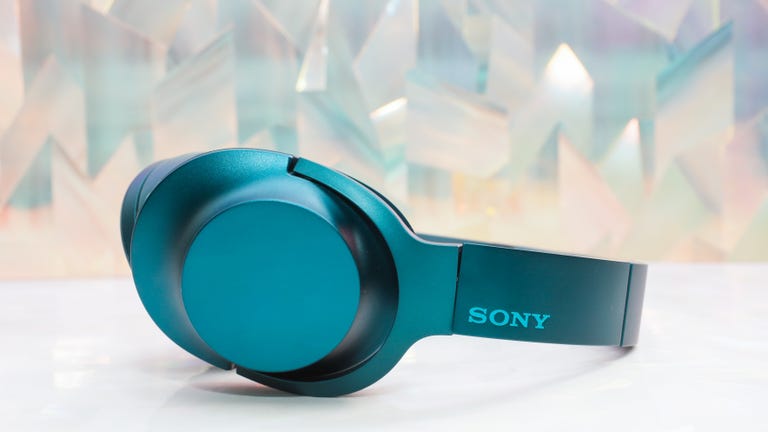 Why You Can Trust CNET
Why You Can Trust CNET Sony H.ear On review: A 'hi-res' headphone that comes in eye-catching colors
Sony's latest headphones have an odd name and a flashy design. But they're not the best-sounding headphones the company currently sells.
You can get Sony's H.ear On headphone ($200, £150, AU$300) in standard "charcoal" black, but what makes it stand out is the vibrant, eye-catching colors it comes in, including cinnabar red, lime yellow, Bordeaux pink or the viridian blue pictured here, which has a lot of green in it.
The Good
The Bad
The Bottom Line
I'm not sure how -- or why -- Sony came up with the "H.ear On" moniker, but this over-ear headphone's model number is the MDR-100A. Attractively designed, lightweight (8 ounces or 227g) and very comfortable to wear, it folds up to fit in a simple but stylish nylon carrying pouch.
Sony calls it a "premium Hi-Res" headphone, which implies that to get the most out of it you'll need a Hi-Res Audio-compatible portable music player, such as Sony's Walkman NWZ-A17 or the newer and more affordable NW-A25, which costs around $220 online.
The headphones fold up to fit in an included protective carrying pouch.
In the past we've tried more modestly priced high-resolution audio headphones and come away a bit underwhelmed. In other words, just because you put the Hi-Res Audio label on a box doesn't make the headphone a truly high-resolution headphone. At $250, Audio Technica's ATH-MSR7 is the cheapest true high-fidelity headphone we've tested. (We use the term "high-fidelity" to describe highly transparent headphones. Hi-Res is merely a marketing term).
But Sony says the H.ear On MDR-100AAP has Hi-Res Audio chops, with 40mm HD drivers that reproduce sounds up to 60 kHz, augmented bass that's "complemented by lightweight CCAW voice coils which yield high-linearity responses in high-pitched sounds" and domes of the acoustic diaphragms have been titanium-coated to minimize unwanted vibrations.
On a more mundane level, the detachable headphone cable has a one-button in-line remote and microphone that's suitable for making calls with Apple iOS, Android or Windows mobile devices. However, it lacks volume controls.
The cord is detachable and has an integrated one-button in-line remote.
Very good sound, but not great
If you listened to this headphone in a vacuum without comparing it to anything else, you'd probably think it's a very good-sounding headphone with good detail and a fairly neutral sound profile. Neither bass heavy nor as transparent or detailed as the Audio-Technica ATH-MSR7, it's pleasant to listen to, just not incredibly exciting.
For around $70 more (online) you can get Sony's MDR-1A, which sounds richer and more open, with bigger, more energetic bass and more detail. It's also a little more comfortable (its ear pads are softer). The MDR-1A is simply more dynamic -- and yes, exciting.
CNET Editor Ty Pendlebury summed it up by telling me that he got goosebumps listening to Neil Young's "A Man Needs a Maid" track over the MDR-1A but got no such reaction when listening to the same track over the H.ear On MDR-100A. Like me, he thought this was a good headphone, but not truly excellent like the MDR-1A.
Should cost a little less
In a nutshell, the H.ear On is a very good headphone that should just cost a little less. It doesn't quite look or feel like a $200 headphone should, and if you're not careful and scrape it up against something, the beautiful finish can end up rubbing off where the headphone got dinged. And that will tarnish the look a bit.
Hopefully over time the MDR-100A will come down in price to around $150. It's a likable headphone, but it faces stiff competition in this price range, including from Sony's own MDR-1A, which doesn't cost much more online and is clearly a superior headphone.
Editors' note (April 7, 2016): Clarified that the Sony MDR-1A costs around $70 USD more than the H.ear On MDR-100A reviewed here.


